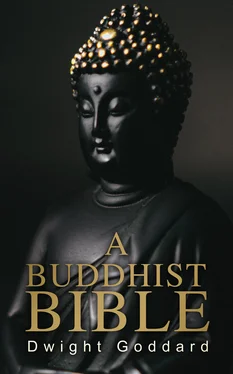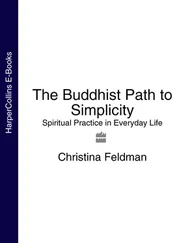Dwight Goddard
The Favorite Scriptures of the Zen Buddhism
e-artnow, 2021
Contact: info@e-artnow.org
EAN: 4066338119797
Preface
History of Ch’an Buddhism Previous to the Times of Hui-neng (Wei-lang)
Self-realisation of Noble Wisdom
Preface
Introduction
Chapter I. Discrimination
Chapter II. False-Imagination and Knowledge of Appearances
Chapter III. Right Knowledge or Knowledge of Relations
Chapter IV. Perfect Knowledge, or Knowledge of Reality
Chapter V. The Mind System
Chapter VI. Transcendental Intelligence
Chapter VII. Self-Realisation
Chapter VIII. The Attainment of Self- Realisation
Chapter IX. The Fruit of Self- Realisation
Chapter X. Discipleship: Lineage of the Arhats
Chapter XI. Bodhisattvahood and Its Stages
Chapter XII. Tathagatahood Which Is Noble Wisdom
Chapter XIII. Nirvana
The Diamond Sutra
Preface
The Diamond Scripture (Vajracchedika Sutra)
Sutra of Transcendental Wisdom
Preface
Sutra of Transcendental Wisdom (Maha-prajna-paramita-hridaya)
Sutra of the Sixth Patriarch
Preface
Sutra Spoken by the Sixth Patriarch
Chapter I. Autobiography of Hui-Neng
Chapter II. Discourse on Prajna
Chapter III. Discourse on Dhyana and Samadhi
Chapter IV. Discourse on Repentance
Chapter V. Discourse on the Three-Bodies of Buddha
Chapter VI. Dialogues Suggested by Various Temperaments and Circumstances
Chapter VII. Sudden Enlightenment and Gradual Attainment
Chapter VIII. Royal Patronage
Chapter IX. Final Words and Death of the Patriarch
Table of Contents
Indian Types of ethical and philosophical Buddhism did not easily find acceptance in China; it took centuries of contact before a distinctively Chinese adaptation of Buddhism was effected that proved to be congenial to Chinese soil. This Chinese type of Buddhism is called Ch’an in China, and Zen in Japan, and Zen seems to be the more familiar name for it in America and Europe. Other sects have risen and decreased but they proved to be more or less exotic, they never became indigenous as did Zen. An exception may be suspected in the case of the Pure Land Sects, but it should be remembered that the Pure Land Sects developed from Zen and not independently.
To tell the story of this adaptation of the Indian type of Buddhism until it became fixed in the teachings of the Sixth Patriarch, is the purpose of this book. The main part of the book is given over to English Versions of the favorite scriptures of the Zen Sect. To this is added Historical and Literary Introductions and a few notes that seem to be called for to make certain phases of the Sutras more easily intelligible.
Let us recall the fact that the knowledge of Buddhism in America and Europe has all come within a hundred years. For seventy-five years of that time it was presented largely by Christian linguistic scholars who were more or less unconsciously prejudiced against it and who very imperfectly understood its deeper implications. It is only within the last twenty-five years that books written by competent and sympathetic Buddhist scholars have begun to appear. Moreover, knowledge of Buddhism has come at first through translations of Pali texts which represent an older and more primitive type of Buddhism. It is only recently that the great Sanskrit texts, revealing the later philosophical and metaphysical riches of the Mahayana type, have been translated and appreciated. Buddhism was represented by the earlier Christian scholars as being "atheistic" and "pessimistic," which a more sympathetic study of the Sanskrit texts has shown to be a misunderstanding and a misrepresentation. Surely, an eternal process based on unchanging law and leading to peace of mind and self-less compassion and the self-giving of Bodhisattvas and Buddhas, and the undifferentiated Love and Wisdom which is Buddhahood and Dharmakaya is far removed from "atheism"; and the "Blissful peace and cessation of change," and the self-realisation of Noble Wisdom, have nothing in common with "pessimism." But intelligent interest in Buddhism is increasing and the old time question, that used to be the only question, "What is Buddhism?" is giving way to a new question, "What type of Buddhism is best adapted to meet modern questions and modern problems?" To answer these questions is this book presented.
Ch’an Buddhism in China and Korea and Zen in Japan, for a thousand years, have been powerful in moulding the spiritual, ethical and cultural life of great nations. Today, when Christianity seems to be slipping, it is the most promising of all the great religions to meet the problems of European civilisation which to thinking people are increasingly forboding. Zen Buddhism, with its emphasis on mind-control, its dispassionate rationality, its cheerful industry, not for profit but for service, its simple-hearted love for all animate life, its restraint of desire in all its subtil manifestations, its subjection of desire to wisdom and kindness, its practical and efficient rule of life, its patient acceptance of karma and reincarnation, and its actual foretaste of the blissful peace of Nirvana, all mark it out as being competent to meet the problems of this materialistic and acquisitive age.
*
The original texts of these Scriptures are very corrupt, disorderly, loaded with accretions and, in places very obscure. The purpose of the present Versions is to provide an easier and more inspiring reading. For scholarly study students are expected to refer to the more precise translations of linguists.
The rules that have been followed in preparing these Versions are as follows:
To omit all matter not bearing directly upon the theme of the Sutra.
To arrange into a more orderly sequence.
To interweave and condense cognate teachings.
To interpret obscure words and teachings .
The need. for this course will be apparent to any earnest minded person who goes to the Scripture for spiritual guidance, inspiration and comfort.
In the Sutras there are certain Sanskrit words that are of great importance to the understanding of the teaching that are difficult to translate in single words. It seems advisable to speak about them at this time.
DHARMA: Law, Truth. Specifically Dharma has come to be used for the Buddha's teaching as a whole, and also as Truth in its universal aspect.
DHARMAKAYA: Truth-body, Truth-principle, Truth-essence. It is used synonymously with such terms as: Buddhahood, Tathagatahood, Nirvana, Noble Wisdom, Universal or Divine Mind, to refer to Ultimate Reality as being universal, undifferentiated, harmonious, inscrutable.
BUDDHA: The Perfectly Enlightened One; the One who has fully attained the goal of spiritual unification.
TATHAGATA: The One who has "thus come." It is used synonymously with Buddha to express the highest personification of Reality. The two terms may be differentiated in the sense that Buddha is the "ingoing" aspect of spiritual attainment, while Tathagata is the "forth-going" aspect of spiritual self-giving and service, both being manifestations of Dharmakaya.
PRAJNA: the active aspect of Dharmakaya; Ultimate Principle of unified Love and Wisdom. It is commonly translated Wisdom but it means far more than that as it includes both the differentiating principle of intellection and the integrating principle of Love. In significance it resembles the Chinese Tao.
ARYA-PRAJNA: Noble Wisdom, synonymous with all other terms denoting Ultimate Reality.
TATHAGATA-GARBHA: The Womb from which emerge all manifestations and all individuations. It is used synonymously with Universal or Divine Mind. Dharmakaya refers to the universal, or pure essence, or "such-ness" of Reality, in contrast to the transformations of the Tathagata.
Читать дальше












